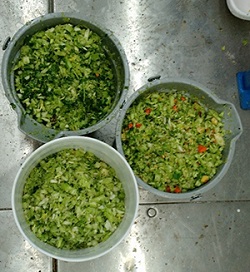 Waste not, want not. That’s the attitude of University of Cincinnati researchers who are turning food waste into biodiesel. This news release from the school says Timothy C. Keener, PhD, and Drew C. McAvoy, PhD—along with fellow faculty members Pablo Campo-Moreno, PhD, San-Mou Jeng, PhD, and George Sorial, PhD—proposed an innovative Smart Cities Project titled “A Pilot Study to Produce Bioenergy and Fertilizer from UC’s Food Waste.”
Waste not, want not. That’s the attitude of University of Cincinnati researchers who are turning food waste into biodiesel. This news release from the school says Timothy C. Keener, PhD, and Drew C. McAvoy, PhD—along with fellow faculty members Pablo Campo-Moreno, PhD, San-Mou Jeng, PhD, and George Sorial, PhD—proposed an innovative Smart Cities Project titled “A Pilot Study to Produce Bioenergy and Fertilizer from UC’s Food Waste.”
The proposal to convert food waste into gaseous fuels, solid fuels, biodiesel and other products was accepted and today, the study flourishes under the direction of Keener and McAvoy. In October 2014, the team launched a pilot plant that has diverted 660 pounds of food waste generated from UC’s Center Court Dining Center for research.
The researchers have since developed a breakthrough synergistic technology that uses anaerobic digestion to turn nutrient-rich organic materials into fuel (biogas), fertilizer, or soil conditioner, while using the carbon dioxide fraction of the biogas to grow algae. Simultaneously, lipid oils in the algae are also extracted and converted to biodiesel.
This novel process, which essentially integrates algae production with anaerobic digestion, allows researchers to almost completely utilize the carbon found in food waste in a renewable manner.
McAvoy explains, “The anaerobic digestion of food waste coupled with algae production seems to be an attractive alternative for not only reducing greenhouse gas emissions, but also for the production of renewable energy.”
The United Nations estimates that “a third of all the food produced in the world is never consumed,” totaling about 1.3 billion tons of waste a year.

